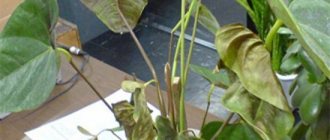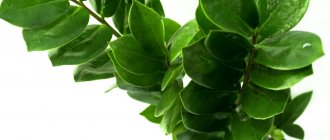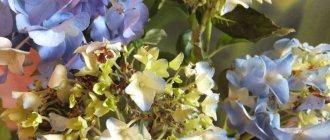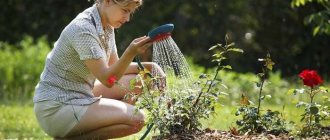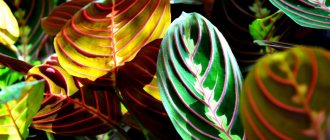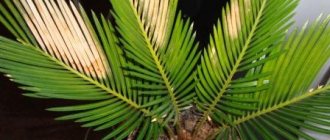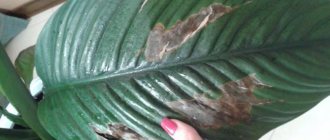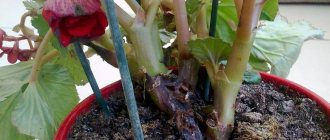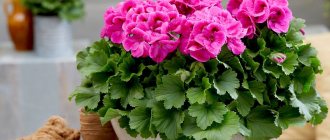- February 21, 2019
- Houseplants
- Sergey Kostyuchenko Zhelyazkov
One of the popular types of tropical plants that can often be found in gardeners' homes is anthurium. This is an evergreen plant with unusual flowers of white, pink, purple or red, which in their bizarre shape resemble flamingos. An unusually beautiful representative of the flora requires careful care, as it is susceptible to a number of diseases, the first sign of which is often yellowing of the leaves.
Do the causes of plant diseases really lie in improper care?
If you are wondering why anthurium leaves dry out and turn yellow, then pay attention to how you care for it. The root cause of all diseases, as a rule, lies in improper care:
- deficiency or excess of sunlight;
- insufficient or excessive watering;
- room temperature that is uncomfortable for the plant;
- insufficient air humidity in the room;
- soil depletion;
- lack of proper feeding and other reasons.
Why do anthurium leaves dry out, and what to do about it?
The leaves of this houseplant may turn yellow for various reasons. Usually they signal errors in caring for the flower, as well as the presence of diseases or parasites.
Violation of the rules for applying fertilizers and watering
The foliage dries out, changes color, and also becomes covered with yellow and brownish spots when the plant lacks nutrients, or, conversely, it suffers due to their excess:
- In the first case, the flower lacks basic nutrients - nitrogen, phosphorus, potassium, calcium, magnesium. The problem is solved by weekly application of liquid store-bought fertilizers to the crop (use only 20% concentration). Some time after treating the plant (when it gains strength), it is transferred to feeding regularly once every 14 days.
- In the second case, in case of an overdose of fertilizers, it is recommended to move the anthurium to a new substrate , having first washed its roots.
Drying along the edges of the sheet with gradual spread over its entire area occurs due to the following reasons:
- Insufficient hydration. This is compensated by observing watering standards and humidifying the environment in the room.
- Due to overflow. If the bush has suffered from excess moisture, then the soil in the flowerpot must be dried or replaced with a lighter one (soil with increased density provokes the accumulation of liquid). When transplanting an anthurium into another substrate, it is necessary to examine the roots and remove those affected by rot.
One of the indirect reasons for fluctuations in the level of moisture in the pot may be a change in temperature or light conditions, since due to these reasons the substrate may dry out faster or slower.
Important! When watering anthurium, it is important to remember: the lower the temperature in the apartment, the less often you should water the flower.
Proper watering of anthurium is carried out using the following technology:
- the soil needs to be moistened only after the top layer of the substrate has dried;
- excess moisture from the pan after watering must be drained;
- in cold weather, watering should be reduced;
- in summer, the flower is watered often, but with a small amount of water;
- for irrigation, slightly warm, settled water with a low level of hardness is used, or filtered, with the addition of oxalic acid (pour 1/2 teaspoon per 5 liters of water).
Incorrect location
Another reason why anthurium leaves dry or turn yellow may be the incorrect location of the plant in the room, due to which it may suffer from the following factors:
- Lack of lighting. If the bush is located in a very dark place, then the cuttings of the newly growing leaves may lengthen noticeably, the leaves themselves will be small, with a pale color, or even turn yellow. When you move a flowerpot with anthurium to a well-lit place, after a while it will regain its decorative appearance, and the yellowness, spotting and drying of the foliage will stop.
- Excess of light. Anthurium foliage should not be exposed to direct sunlight, as this can cause burns on it. Especially if there are drops of moisture left on the leaf plates - under the sun's rays they will act like lenses, burning through living tissue and leaving brownish spots. Therefore, after watering, you should always remove drops of water that have fallen on the leaves with a dry sponge or napkin. The plant itself must be shaded with curtains or blinds during periods of active solar radiation.
Read more about why anthurium does not bloom, and what to do if its leaves dry out.
Unsuitable growing container
The choice of pot in which it will be grown is also important for the health of anthurium. If the container is too large or made of the wrong material, the plant will begin to hurt, its roots may rot due to the accumulation of moisture at the bottom, and this will immediately affect the color and appearance of the leaf blades.
To save the plant, the following measures must be taken:
- Choose a container made of plastic (in a ceramic pot with thicker walls, the flower suffers from the temperature difference between the ambient air and the soil in the pot);
- The flowerpot should be somewhat cramped and low, with a diameter of 25–30 cm.
- A drainage layer must be placed at the bottom of the container, since the culture does not tolerate stagnant liquid.
- When replanting a plant, it is necessary to cut off the rotten ends of the roots, treating the sections with burnt wood powder.
- Fill the container with new substrate.
Did you know? In the natural environment of tropical rainforests, anthuriums turn their leaves to follow the movement of the sun in the same way that sunflowers turn their inflorescences behind it.
Diseases and pests
There are anthurium diseases that are manifested by changes in foliage color and drying out:
- Septoria. A contagious disease in which the leaves turn yellow and begin to dry out. Often the flower cannot be saved.
- Chlorosis. The disease is non-infectious and occurs due to a lack of vital microelements (iron, magnesium). The leaves are covered with yellowish, dark green or brown spots, while the veins retain their green color. For treatment, medications containing magnesium and iron are used.
- Gray rot. Causes brown spots to appear on leaves. Appears due to high humidity levels or frequent watering. The plant must be isolated, and the affected areas of the plant must be pruned. At the onset of the disease, you can spray the plant twice with Fitosporin (the second time after 7 days). In the advanced stage of the disease, the flower is destroyed.
- Rust. A fungal disease causes spots on the upper parts of the leaves, and spots filled with powder with spores appear on the reverse side. Subsequently, the spots begin to merge and the leaves dry out. The described fungus is treated with fungicides (Fitosporin-M or copper-containing preparations).
- Fusarium. A fungus that attacks the leaves, causing them to turn yellow, wilt, and then fall off. An effective method of control is unknown, so the infected flower will most likely die.
Sometimes it happens that after purchasing an anthurium, pest damage is discovered on the plant.
Among them are the following:
- Aphid. The dominance of these tiny insects on anthurium leaves leads to yellowing and deformation of the foliage, and subsequently sticky traces from the vital activity of parasites remain on the leaf plates. Weak insect infestation is eliminated with a soap solution, and in case of severe infestation, the preparations “Fitoverm”, “Antitlin”, “Aktellik”, etc. are used.
- Scale insect and false scale insect. When affected, the surface of the stems and leaves of anthurium becomes covered with whitish or golden-brown tubercles. In case of minor pest infestation, it is necessary to remove them mechanically (with a toothbrush), and then wipe the affected areas with a sponge soaked in kerosene (this causes the parasites to suffocate under the resulting film). Treating the plant with a petroleum mineral oil insecticide will also help.
- Spider mite. Initially, the presence of the pest is accompanied by the appearance of yellowish specks on the leaves, and later - extensive discolored and dried areas. Mites occupy the underside of the leaf, spinning a web there. Light mite infestation can be eliminated by treating the plant with mineral oil or soap, and severe infestation can be eliminated with Fitoverm, Molniya, Vertimek, etc.
- Thrips. When affected by thrips, an uneven white-yellow color appears in some areas of the foliage. There are also dark discharges at the bottom of the leaves. With a strong attack of parasites, the leaves dry out and fall off. To destroy these parasites, you need to spray the anthurium with an insecticide, for example, “Aktellik”, “Aktara”, “Fitoverm”, “Fufanon”, etc. After 5 days, repeat the treatment.
Important! There should be no strangers or animals in the room where insecticides are used to control parasites. When using medications, strictly adhere to the protective measures, as well as the dosage recommended in the instructions for them.
The main means of combating insect pests of anthurium will be prevention - daily inspection of all plants, as well as periodic treatment of each leaf with solutions of laundry soap and copper sulfate.
Optimal conditions of detention
Since anthurium comes from the tropics, it is best to keep it in greenhouses, winter gardens and other premises in which conditions are as close as possible to its natural growing environment. You can try to create a beneficial environment for the plant at home, then it will grow without problems, delighting you with regular flowering. If conditions do not meet its requirements, the appearance of the flower will indicate problems.
Why do the leaves turn yellow and what mistake in care causes harm to the flower?
Firstly, it's a change of scenery. Because you need to get used to the change in environment and climate. Secondly, this is improper care. Almost everyone thinks that the more often you water a flower, the better. But such a thought is erroneous. Why is there no need to do this? Since not all flowers need a lot of moisture. But the soil in the pot should not be allowed to dry out, so as not to have to save the plant from diseases.
Consequences of improperly growing plants
Since anthurium is a tropical flower, it is moisture-loving. But you need to know when to water the plant. You need to water the flowers often, but little by little; the plant also likes to spray its leaves. Why does watering affect a flower? You should know that abundant and frequent watering can cause root rot. Water quality also plays an important role. The condition of the flower depends on the level of water hardness.
Secrets of keeping the flower “Male Happiness”
To reduce the level of danger, you can use settled water for irrigation. You need to stand for 10–12 hours. But it is best to use filtered water. The water should be at room temperature so that the flowers do not freeze.
Anthurium leaves turn yellow: reasons
The plant likes to have a lot of light; it should be placed on the sunny side. But at the same time, in the hot season, under direct sunlight, it can also turn yellow. A balance must be maintained: there should be a lot of light, but overly aggressive exposure should be minimized. The optimal temperature for the room is +20…+25 °C.
Watering is required abundantly, but the water should not stagnate, as this can lead to rotting of the root system. The optimal level of air humidity is in the range of 85-90%. In order to record it, it is advisable to purchase a hygrometer. You can increase humidity by using a humidifier. Anthurium should not be located near heating devices.
The plant should be fertilized regularly during the period of active growth with a special mineral liquid concentrate according to the instructions.
Tips for caring for anthurium
Regardless of the variety, age or color of the plant, the owner needs to know the tricks of growing.
The flower loves a cramped pot.
- Loose soil promotes growth.
- The room is well ventilated.
- Proper watering.
- Scattered light.
- Relative humidity.
- Leaves turned brown - hard water or dry air.
- Spider mites have appeared - there are not enough vitamins.
- When replanting, enrich the soil with sphagnum.
- When watering, make sure that the roots are not in water.
- Anthurium loves an acidic environment.
- Aerial roots also need spraying, this helps maintain high humidity.
- You need to water the flower once every 4 days if the temperature is above 20 °C, and in winter - once a week.
- The leaves are constantly cleaned of dust. A good soil for anthurium will be a mixture of peat, coarse sand, rotted bark and heathery fibrous soil.
- During growth, the bush is fed with organic fertilizers once every 2 weeks.
Anthurium is an unpretentious flower. He does not require increased self-care. Timely watering, proper lighting and temperature conditions will play a positive role in growing this creature. The latter will generously reward you with flowering and a healthy appearance.
Originally posted 2018-02-18 14:09:10.
Timely transplant
If the above conditions are met and the problem remains, the cause of yellowing may be a cramped pot in which the plant has been “living” for several years and there is simply not enough space for the roots. Most likely, the soil in it has already been depleted, has become harder, and does not allow moisture to pass through well. For this reason, the leaves of anthurium turn yellow. What to do in this case? The tips are as follows:
- The flower should be carefully transplanted into a larger pot without damaging the roots.
- Be sure to place drainage at the bottom of the container so that air and water pass through the soil.
- Choose a special soil: loose, fibrous, acidified. It is advisable to carry out replanting with protective gloves, since the plant is poisonous and its juice can cause irritation to the skin.
Yellowing after transplantation
Immediately after changing the soil or moving the plant to a new pot, yellowness may appear. Then the changes indicate damage to the roots, increased soil moisture, or simply adaptation to changed conditions. Anthuriums are replanted every 2 years, as the soil is depleted and the root system grows.
This should also be done immediately after purchasing a plant at a flower shop. Then you need not only to transplant the anthurium into a new pot by transshipment, but also to thoroughly wash the underground part of the flower from the transport soil and completely replace it with fresh one. The procedure should be performed very carefully so as not to break the delicate roots. Otherwise, in the future, rot will develop, and the leaves will begin to turn yellow and fall off.
The pot for anthuriums should not be too large. The distance between the old lump of earth and the walls of the new container should be 2-2.5 cm. Otherwise, the soil mixture will be constantly wet, which increases the likelihood of rot and pathogenic bacteria. Be sure to place a good drainage layer on the bottom. There is no need to water the plant for three days after moving it. At this time, you are only allowed to spray the flower with a spray bottle, building a greenhouse over it from a bag.
Anthurium leaves are turning yellow, what should I do? Change irrigation water immediately
The capricious flower reacts painfully to chlorine, high concentrations of salts, and hard water. Water with excess limestone causes yellowing of the foliage when it gets on it during watering. Unfortunately, this is a common story in urban areas.
So, the banal reason why anthurium leaves turn yellow is poor-quality water for irrigation. What to do? Tap water should be left to settle for several days and only then used for irrigation. It is also good to collect rainwater for this purpose. Boiled or filtered is also suitable.
How to cure anthurium
Anthurium - home care: why leaves dry
Procedure if yellowing is detected:
- It is recommended to remove leaves that have turned yellow. This will help the plant recover faster.
- If the cause of deterioration is improper care, the situation must be improved. To do this, you need to install an air humidifier and strictly follow the watering and fertilizing plan.
- The flower must be replanted in strict accordance with all the rules, using only pots of the correct shape and size.
- If rot is the source of the problem, you need to remove the flowers from the pot, rinse the roots with warm water and carefully inspect them. Plants can be preserved by placing them in a disinfectant solution for 20 minutes. After this, the roots need to be dried, the plant should be transplanted into a new container and watered, wait until new leaves begin to grow.
Lighting is important for anthurium
Pests interfere with normal life activities
When such a problem occurs, flower owners should carefully examine the leaves, stem, and root zone for possible pests. Most often, the plant is attacked by a variety of mites, scale insects, aphids, scale insects and other insects. If anthurium leaves turn yellow for this reason, what should a gardener do? The procedure is as follows:
- Remove insects and their larvae by washing the flower with water.
- Treat the plant and root zone with a soap solution.
- Apply an insecticidal mixture, after which the plant must be washed well, since drugs of this type are quite toxic.
In some cases, repeated treatment with chemicals will be required, since after two to three days some pests, such as spider mites, hatch young. For prevention, the procedure should be repeated after another week.
To improve the effect in pest control, after treatment, you need to tightly close the flower for a couple of hours with a plastic bag. Insect control must be carried out in a timely manner, as they can easily spread to other indoor plants, and then it will be much more difficult to deal with them.
Diseases and pests
Yellowing of the leaves of the plant may be due to an attack by pests to which the interior is susceptible. Often the cause is damage to the root system. The following table will help you understand the most common plant diseases that cause yellowing of leaf blades.
| Anthurium diseases | ||
| Name | Causes and symptoms | How to fix |
| Gray rot | High humidity in the room is the main reason. At the beginning of development, yellowing of the leaf plate can be seen, and then it becomes covered with a white coating. You can get rid of the problem if it is detected at an early stage, otherwise the plant may die. | Anthurium should be removed away from other plants in the room. Reduce watering and completely stop spraying. Apply the fungicide twice and transplant the bush into new soil. |
| Septoria | The cause of development is a fungal infection. Yellow spots appear on the leaves, which grow over time. The plant quickly dries and withers. | When the first signs of damage are detected, the damaged leaves are removed, and the plant itself is sprayed with a fungicide to destroy the infection. |
| Anthracosis | The cause of the development of the disease is poor-quality treatment of the soil used for planting. White spots appear on the leaf, and yellowness appears along the edges. | Replace the soil and pot, reduce watering and stop spraying. Neighboring plants are treated with copper oxychloride. |
| Chlorosis | It can often be triggered by a lack of iron or magnesium in the soil. The foliage becomes withered, the dividing veins disappear. The leaves dry out and then fall off. | The soil should be enriched with mineral compounds containing these components. The condition of the plant should return to normal. |
| Root rot | It develops rapidly, leaves fall off quickly and in large volumes. | Emergency replanting with washing of old soil helps to save the plant. There needs to be good drainage at the bottom of the pot. |
The reason for the yellowing of anthurium leaves may be due to increased pest activity. The leaf axils should be carefully examined for the presence of scale insects, spider mites, aphids and powdery mildew.
The following video will tell you about the dangers of iron deficiency for a plant:
When insects are detected, they are treated with a soap solution prepared on the basis of laundry soap. The plant must be isolated from others. Insecticide treatment is also indicated.
Diseases associated with activation of fungi
The tropical flower is moisture-loving. Trying to maintain humidity at the proper level, we simultaneously create a favorable environment for the development of harmful fungi. They multiply quickly in a warm and humid environment, infect leaves, which become covered with yellow and brown spots, gradually dry out and die. The most typical fungal formations:
- Septoria - brown formations on the foliage, edged with a yellow rim. The leaves die over time, and after a certain time, if there is no action, the plant itself dies.
- Anthracnose - leaves dry out and become thinner.
- Downy mildew - yellowish spots on the surface of the leaf, grayish spores on the inside
- Stains with a hint of rust.
One of the main signs of fungal diseases in anthurium is yellowing leaves. What to do if these symptoms appear?
First, reduce the humidity. Secondly, treat the soil and the plant itself with a fungicidal preparation. Bordeaux mixture is very effective, especially in the fight against septoria. Thirdly, do not forget about preventive measures and periodically treat the soil with special protective preparations.
Why do anthurium leaves not only turn yellow, but also dry out?
The combination of yellowing leaves and drying out is an unkind sign. The reason may lie either in violation of the conditions of detention or in a serious illness. If the leaves turned yellow or brown and then began to dry out, you exposed the flower to hypothermia or watered it with cold water overnight, causing the roots to freeze. Do not forget to remove the pot from the balcony in time in the fall and not leave it there in the spring until the end of frost.
The foliage of the crop will give the same signal in case of sunburn. The tropical guest loves light very much, but direct rays of the sun are dangerous for him. Experts recommend placing the pot on an east or west window. For a southern location, use a tulle screen or a special reflective film.
Drying of foliage along with yellowing may be a consequence of the development of a fungal disease. This symptom is characteristic of Fusarium wilt and anthracnose. Fungicides will help fight the disease. Spraying is carried out twice with an interval of 7-10 days.
Remember! If drying and yellowing of the foliage is accompanied by a loss of turgor, check the substrate. Surely you missed the next watering of your pet, so it began to wither.
The main causes of the disease and recommendations on how to cure the plant
Anthurium does not often get sick or suffer from pest damage; in most cases, yellowing of the leaves is associated solely with improper care. It is important to monitor the condition of the plant and take action before the damage to the flower becomes irreparable.
Excess moisture
One of the most common reasons why leaves turn yellow and wither is excess moisture, which over time leads to rotting of the roots and damage to the plant by mold or fungus.
The reasons are usually the following:
- excessive watering;
- incorrectly selected substrate;
- pot too spacious;
- insufficient or improperly organized drainage.
What to do in this case? First of all, it is necessary to normalize the watering regime; if this does not have a beneficial effect on the plant, it means that the roots have been seriously damaged and only replanting will help, during which it is necessary to remove all damaged areas of the root system and place the anthurium in a properly selected substrate and pot.
Attention! Anthurium juice is poisonous and can cause a serious allergic reaction or food poisoning, so all manipulations with the plant that can cause damage must be carried out with gloves, and after finishing the procedures, wash your hands thoroughly.
Lack of lighting
Plants native to the hot tropics often lack light when kept indoors. Despite the fact that anthurium is classified as a shade-tolerant species, in twilight its leaves begin to turn pale and yellow.
The situation can be corrected by moving the plant closer to the light source; for healthy growth and flowering in the warm season, anthurium needs bright, diffused lighting lasting at least 10 hours.
Direct sunlight should be avoided, as it causes burns on the leaves (yellow or pale brown spots) and can cause general overheating of the plant.
Incorrect feeding
From April to August, almost all indoor plants need additional feeding, as this is the period of growth and flowering.
If fertilizer is not applied, the lower leaves may begin to turn yellow and fall off. This happens because there are not enough elements in the soil necessary for the appearance of new leaves, and the plant takes them from old ones. In this case, it is enough to start using fertilizers.
An excess of fertilizing can be as destructive as its lack. Too much fertilizer in the soil can cause root burns, which will inevitably lead to wilting of leaves and shoots.
If excessive fertilizing is suspected, the use of fertilizers should be stopped immediately. If the plant’s condition has not returned to normal within a week, it is necessary to transplant it into a new substrate, removing damaged areas of the roots in the process.
Hypothermia
If a flower is in a draft, next to an air conditioner or exposed to low temperatures (below +15 degrees), its leaves will begin to become soft, turn yellow and become covered with dark spots (for what other reasons spots of different colors may appear on the leaves, we tell here). It is important to restore the temperature regime and remove the anthurium away from cold air currents. It is better to remove damaged leaves to speed up the recovery of the plant.
Fungus
Brown spots and yellowing of leaves may indicate a fungal infection, which can be prevented by treating the entire plant, including the root system, with a fungicide. It is best to remove damaged leaves.
Read here what other diseases can threaten anthurium.
When is yellowing of a flower Male happiness considered normal?
Aging is a natural process inherent in any living organism, anthurium is no exception. Old leaves turn yellow and fall over time, the intensity with which this happens directly depends on the age of the plant, as a rule, no more than 1-2 leaves per year. If new leaves have grown to replace the fallen ones and the plant generally feels good, the situation does not require taking any measures.
Another cause of yellowing leaves that does not require concern is stress (for example, after moving or replanting). If you follow all the rules of care, the anthurium will quickly adapt to the changes and its foliage will again acquire a bright green color.
Important! If a week after transplanting or moving the plant continues to turn yellow and wither, it means that the cause is not only stress. In this case, it is necessary to understand as soon as possible what negatively affects anthurium and eliminate this factor.
What to do
In order for Anthurium to drop its leaves and not die, it is necessary to strictly monitor the lighting, do not leave it in direct sunlight, and in winter add ultraviolet light. Only warm air temperature without drops or drafts. To achieve high humidity, additionally spray the plant with warm water. Use complex mineral fertilizers, paying special attention to concentration volumes.
Often, a change in leaf color indicates a problem with the root system. Therefore, an unscheduled inspection of the flower is carried out, a transplant is carried out and corrective measures are taken. Only after the tropical miracle has grown stronger can it be moved to permanent soil for further cultivation.
The worst reason is the appearance of spider mites. To prevent development, spraying with a special solution is carried out, and the use of acaricides is allowed. After normalization of the condition, the flower is transferred to a new and more spacious place of residence.
Flower diseases, treatment and prevention
Most often, anthurium diseases appear due to improper care, among which the largest place is occupied by overwatering and hypothermia, and as a consequence of this, rotting of the root system.
Infectious diseases pose a great danger to the plant: anthracnose, fusarium, septoria, as a result of which the plant often dies even after treatment.
It is easier to deal with rust on leaves and various root rots. And almost all plants recover and improve their appearance if the cause of the disease was improper care.
Treatment of infectious diseases
Many infectious diseases lead to the death of the plant, but you still need to try to save the plant.
First of all, we isolate the damaged plant from the rest, examine it and make a preliminary diagnosis.
When working with fungicides, be sure to use personal protective equipment and do not eat or drink.
Fusarium wilt is an infectious disease in which the mycelium of the fungus penetrates the living tissue of the plant and clogs vital vessels. Root rot appears, spreading into the trunk. Leaves that do not receive nutrition quickly wither and the plant dies. The best way to fight is prevention. When planting, several grains of Trichodermin are added to the soil mixture to maintain the high vitality of the plant. You can try to save a diseased anthurium by cutting off the living upper part and rooting it, after soaking it in a solution of Fundazol for about 30 minutes.
Root rot most often occurs when the plant is constantly overwatered. Treatment is trimming the rotten parts of the roots and treating with Fitosporin-M or Maxim, transplanting into a new substrate and preferably a new pot.
Rust is a fungal disease that appears on all parts of anthurium, but most often on the leaves. For the purpose of prevention, at low temperatures and high air humidity, treatment can be carried out with Fitosporin, and in case of an already existing disease - with Topaz, Ordan.
Powdery mildew appears when the temperature drops sharply and humidity increases. Preventive measures - do not spray anthurium in cool weather (winter maintenance). Treatment of powdery mildew - place the pot in a warm, dry place, spray with Topaz or Acrobat.
Anthracnose appears due to high humidity, which is exactly what anthurium loves. The causative agents of the disease - fungi of the genus Colletotrichum and Kabatiella - may not manifest themselves for a long time, but when favorable conditions arise for them, they begin to infect the plant. Usually the first symptoms appear on the leaves in the form of spots, which become more and more numerous. The affected leaf shrinks, becomes thinner and becomes like tissue paper. Then anthracnose attacks the stems and almost the entire plant dries up on the root. Treatment of anthracnose should be started as early as possible. The first step is to remove all damaged leaves and destroy them. The soil is changed to a new one, and the roots of the anthurium are disinfected. The plant is quarantined with a decrease in air humidity and a reduction in watering. It is strictly forbidden to spray, since fungal spores are carried by water droplets. If the plant is very sick, then use fungicides: Baktofit, Fitosporin, Fundazol, Ridamin Gold, Silk. Spray the plant 2-3 times every 10-14 days.
Fungal diseases
The most common fungal infections are stem rot, root rot, septoria, fusarium, powdery mildew and rust.
To treat fungal diseases, fungicides are used, special preparations for diseases of indoor flowers, and only them!
Stem rot
If you regularly water the flower, if after watering excess water sits in the tray for a long time, if the room temperature is below the permissible level, the anthurium will almost certainly develop a disease such as stem rot. Watery black spots will appear on the stem. The rot will gradually spread to other parts of the plant and the leaves will begin to rot. The affected parts of the plant will die. On the affected areas, under a magnifying glass, small sporangia are visible, initially white, then turning black.
What to do? Isolate the diseased flower. Trim off all affected parts of the plant. Spray the plant with fungicides, such as phytosporin, twice, at intervals of a week. Check the plant for pest damage. Perhaps he was attacked by thrips. If the disease is advanced, the flower must be destroyed. Check the living conditions of other flowers to prevent them from getting sick.
This may be interesting: Anthurium: indoor flower pests and how to control them at home
Root rot
Frequent watering, low temperature, poor drainage in a flower pot and other deviations from the norm can cause this disease. When the roots of a plant rot, its leaves noticeably turn pale, and then turn yellow and begin to wither. The roots become soft and rotten. The root sheath peels off from the middle and the roots look frayed.
If the disease has not yet started, sharply reduce watering of the plant and reduce the air humidity in the room. Trim off wilted leaves. Remove the plant from the pot, free the roots from the soil, trim off any damaged or rotten parts, and if there are areas of healthy root system left, plant the anthurium in a new pot with suitable healthy soil. Don't forget about drainage! Water the plant with Fitosporin-M or Alirin-B. Wait, the result should be positive. If the disease is advanced and rotting has affected all the roots of the anthurium, it will not be possible to save the flower; it will most likely die.
Septoria
Brown spots of irregular shape with a yellow or brown border appear on the leaves. Under a magnifying glass, tiny black dots of sporangia can be seen on the spots.
What to do:
Severely affected leaves should be picked and removed. Reduce air humidity. Stop spraying the plant with water. Feed the flower with fertilizer for flowering plants. Inspect for pests. If there are none, spray with Fitosporin-M or copper-containing preparations.
Fusarium
With fusarium blight on anthurium, massive leaf wilting begins. They turn yellow and dry out, and then fall off. A white coating with a pink tint has appeared on the root collar. A very dangerous disease. The infection is spread by water when watering plants when air humidity and temperature are too high.
If the disease is in its early stages, try spraying the above-ground part of the plant with a fungicide, and add a soil pesticide to the soil. Repeat treatment after 5 – 7 days. But keep in mind that there is no effective way to treat fusarium. A diseased plant will most likely die and will need to be destroyed!
Powdery mildew
The leaves of the anthurium began to turn yellow and curl. Their defeat is similar to chlorosis. But if the leaves not only turn yellow, but become noticeably smaller, the internodes grow shorter and shorter, then this is not chlorosis, but powdery mildew. Light gray spores are clearly visible on the back of the leaves - this is a fungus. If the infection is severe and left untreated, the leaves will dry out completely. What to do? Treat! Using fungicides. (for a description of the treatment of fungal diseases, see above)
Rust
If light spots appear on the upper side of the leaf and brown pustules on the lower side, your anthurium has most likely become infected with a fungal infection called rust. On the underside of the leaves, spores develop rapidly, the spots merge together and the leaves dry out completely. This disease must be treated with fungicides. (for a description of the treatment of fungal diseases, see above)
This may be interesting: Clerodendrum - home care
